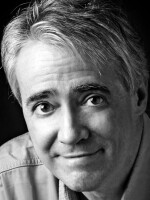Author Simon Singh's new book is Big Bang: The Origin of the Universe. The author speculates about what came before the birth of the universe, and what may eventually happen at its end.
An Excerpt from 'Big Bang'
In 1948, George Gamow and his student Ralph Alpher tried to show that the Big Bang model of creation could explain the abundances of the light elements in the universe, such as hydrogen and helium.
As each month passed, Ralph Alpher became increasingly convinced that he could accurately model the formation of helium in the few minutes after the Big Bang. His confidence increased when he found that his calculations agreed closely with reality. Alpher estimated that there should be roughly one helium nucleus for every ten hydrogen nuclei at the end of the Big Bang nucleosynthesis phase, which is exactly what astronomers observed in the modern universe. In other words, the Big Bang could explain the ratio of hydrogen to helium that we see today. Alpher had not yet seriously attempted to model the formation of other elements, but even predicting the formation of hydrogen and helium in the observed proportions was in itself a highly significant achievement. After all, these two elements accounted for 99.99% of all the atoms in the universe.
Keen to announce their breakthrough, George Gamow and Ralph Alpher set out their calculations and conclusions in a formal paper entitled 'The Origin of Chemical Elements', and submitted it to the journal Physical Review. It was due for publication on 1 April 1948, and perhaps this was what spurred Gamow to do something he had been secretly considering for many months. Gamow was a close friend of Hans Bethe, who was famous for his work on stellar nuclear reactions, and he wanted to add Bethe's name to the list of authors, even though he had contributed nothing to this particular research paper. His motivation for adding the extra name was that readers could enjoy the sight of a paper authored by Alpher, Bethe and Gamow, a pun on the Greek letters alpha (a), beta (b) and gamma (g).
Not surprisingly, Alpher took exception. He feared that crediting Bethe would diminish how the rest of world perceived his own contribution to the research. Alpher's name was already overshadowed by Gamow's co-authorship, because Alpher was the young Ph.D. student and Gamow the famous physicist, and adding Bethe's even more eminent name would only make things worse for him. Alpher had done more than his fair share of the work, and now it seemed that he was going to receive only a tiny fraction of the credit.
The paper was posted off for publication, which meant that Gamow could now relax a little, but Alpher still had plenty of work to do. This research was Alpher's Ph.D. project, so he had to write it up independently and in excruciating detail to demonstrate that he was worthy of a doctorate and was fit to climb the academic ladder. Once he had written his thesis, Alpher then had to undergo the ordeal of defending it. He would have to sit alone in front a panel of experts and convince them that hydrogen and helium could have been created in the correct proportions in the moments after the Big Bang. He also wanted to argue that there was a reasonable chance that other atoms could also have been created during this phase. Essentially, he was going to defend the results of his collaboration with Gamow, but relying solely on his own wits, unable to turn to his mentor for advice. If he succeeded, he would be awarded his Ph.D.
Such thesis defences are often public occasions, but it is not a spectator sport with mass appeal, so the audience tends to be just friends, close family and a few academics with a particular interest in the subject. In this case, however, news that a twenty-seven-year-old novice had made a major breakthrough had spread across Washington, and Alpher found himself arguing his case before a packed audience of three hundred, including newspaper reporters. At the end of his defence, the examiners were sufficiently convinced to award Alpher his doctorate.
Meanwhile, reporters had taken special note of one of Alpher's comments - that the primordial nucleosynthesis of hydrogen and helium had taken only 300 seconds. And that was what made the headlines in newspapers all across America over the next few days. On 14 April 1948, The Washington Post announced WORLD BEGAN IN 5 MINUTES. For few weeks Alpher enjoyed a degree of celebrity. Academics showed interest in his work, a curious public sent him fan mail and religious fundamentalists prayed for his soul.
However, the spotlight soon faded and, as he suspected, he became lost in the shadow of his illustrious co-authors, Gamow and Bethe. When physicists read the paper they assumed that Gamow and Bethe were responsible for the major breakthrough, and Alpher's name was overlooked. The spurious addition of Bethe's name for comic effect had extinguished any hope that Alpher may have had for some long-term recognition. Today, even physicists are largely unaware of Alpher's crucial role in the history of the Big Bang model.
Copyright 2023 NPR. To see more, visit https://www.npr.org.



